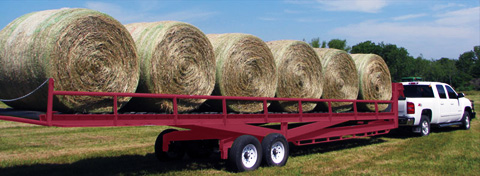
By Del Williams
From Cattle Today
When a farmer or rancher has to clear fields of round hay bales, there’s nothing that does the job like a hay trailer. But what kind is best for you? That depends on your equipment (tractor or pick up), your use (bale size, quantity, and labor), and your budget.
If you’ve got enough tractors and labor, and would like to minimize the up front cost of a trailer, then traditional inline, self-unloading hay trailers are a good choice. These trailers typically load bales with a tractor’s hayforks from the rear, until the trailer’s cradle is full. When the trailer reaches its destination, a lever is pulled and the hay bales are rocked then rolled off the cradle by gravity.
If a farmer or rancher is choosing a traditional inline, self-unloading hay trailer, there are two questions they need to ask: 1) How reliable do I want the trailer to be, and 2) How long do I want it to last?
For those hauling less hay, for less time, and lighter bales, a typical trailer will do. Still if you don’t want your hay trailer in the repair shop when it’s time to bring in the bales, it’s important to look for at least a few quality features.
For instance, it’s best to choose a trailer with a frame at least 5′ wide. Many inline hay trailers only use a 4′ wide frame to save on freight shipping cost. But sitting a 6′ wide bale on top of a 4′ wide trailer frame makes a load more top heavy and less stable. This becomes a problem on fields filled with berms, terraces, gopher holes, and ditches. Too often, when narrow trailers hit a ditch, the whole load is dumped.
With many trailers, hauling 6,000-12,000 lbs. of bales per load, another caution is to choose a trailer with a double latch system, since latches hold the load in place until it’s ready to dump. Single latch trailers are prone to tearing the sidewall off the main tube over time, which can require cutting off the latch, regrinding, and rewelding. A double latch system cuts the latches’ metal fatigue in half as bale weight is dispersed, improving safety and reliability. A linkage between the latches also allows them to operate with only one lever.
For heavy bale loads, more loads, long use, consider a hay trailer that’s built to last. Besides an extra wide 5′ frame and double latches, trailers such as the Red Rhino or the Competitor Bale Handler use more steel in the cradle, neck, axles, main tube, and rail supports.
Since the main tube is the backbone of the hay trailer, some are built heavier than other manufacturers. The Red Rhino trailer, for example, is built with an 8 5/8” OD .352 wall thick main tube. Typical hay trailers use 8” square .188 wall tubing or 8 5/8” OD .250 wall. Rail supports are also critical because they carry most of the bale weight and should be made of more steel.
Since bale capacity can determine how many trips you have to make to clear the field, it’s important to consider this as well. Hay trailers typically range from 21′-40′ long, with a 32′ trailer carrying about 6-8 bales. When capacity is a concern, it might make sense to consider some of the larger inline hay trailers which can haul 9-11 bales at once.
Farmers or ranchers wanting the speed and convenience of staying in their tractor or pick up while loading or unloading bales should consider self-loading/unloading hay trailers. With these hydraulically operated trailers, it’s a one-person operation that doesn’t take physical strength. If they choose a pick up-capable version, it doesn’t even require a tractor.
In fact, some farmers and ranchers find they can dramatically improve productivity with their existing equipment if their wife hauls baled hay in a pick up-pulled trailer while they bale hay with the tractor. This can remove the bottleneck of waiting for one person to do all the work with a single tractor.
While self-loading/unloading trailers initially cost more than inlines yet save much labor, it may make sense to consider a simpler machine with few moving parts like the 2EZ Bale Mover. It’s designed to gently but hydraulically pick bales straight up and set them straight down when its rails slide under or away from the bales. Because it has few moving parts, this can mean less cost, maintenance, and downtime. Its design allows even old and mis-shaped bales to be transported with no further damage. Since its design keeps a single side of the bale in contact with the ground, it also saves hay by minimizing the number of bad hay spots caused by ground-absorbed moisture.
Since it loads bales individually or up to six at a time, using your tractor or truck, it can unload the whole load at once or one at a time. Come winter, when it’s time to feed the cattle in pasture, this ability can turn three typical trips with a tractor and hayforks into one with a pick up and hay trailer.
While the original bumper pull 2EZ works best with tractors, and the gooseneck model works best with pick ups, the new hydraulic bumper pull model works best for those using both a tractor and a pick up to haul bales. The new hydraulic bumper pull model, in fact, combines the speed of the original bumper pull model with the ground clearance of the gooseneck model.
